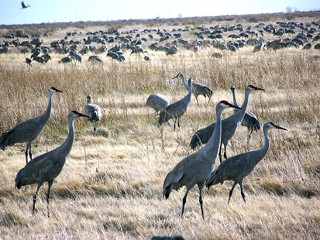"Journey North engages students in a global study of wildlife migration and seasonal change. K-12 students share their own field observations with classmates across North America. They track the coming of spring through the migration patterns of monarch butterflies, robins, hummingbirds, whooping cranes, gray whales, bald eagles— and other birds and mammals; the budding of plants; changing sunlight; and other natural events. Find migration maps, pictures, standards-based lesson plans, activities and information to help students make local observations and fit them into a global context. Widely considered a best-practices model for education, Journey North is the nation's premiere "citizen science" project for children." Journey North Website
The metre high birds have only bred successfully a handful of times in the the UK since 1981 after being absent for 400 years.
Now the Great Crane Project, a partnership between the Wildfowl & Wetlands Trust (WWT), the RSPB and Pensthorpe Conservation Trust, aims to secure the future of the crane as a British breeding bird.
Eggs brought over from Germany will be incubated, hatched and hand-reared at Slimbridge. Work is expected to start this summer and be complete by spring 2010. Once ready, the birds will be released into the wild on the Somerset Levels, where there is existing habitat suitable for them to nest and feed in..
Debbie Pain, WWT's director of conservation, said the breeding programme will help the birds to learn how to live in British wetlands again at "crane school" where the birds are taught how to adapt.
She said: "Cranes are magnificent birds driven from their wetland habitats and hunted to extinction long ago. Now we are determined to give them another chance at survival.
"Thanks to lessons learnt in crane school we now have the feathery-fingered skills to raise crane chicks. Roll on 2010 - we cannot wait to begin teaching these amazing birds how to live in British wetlands once again."





